Hard apple cider is probably one of the simplest home brewing recipes. Using store-bought apple juice makes this recipe even simpler. Best of all, homemade hard apple cider is refreshing and delicious!
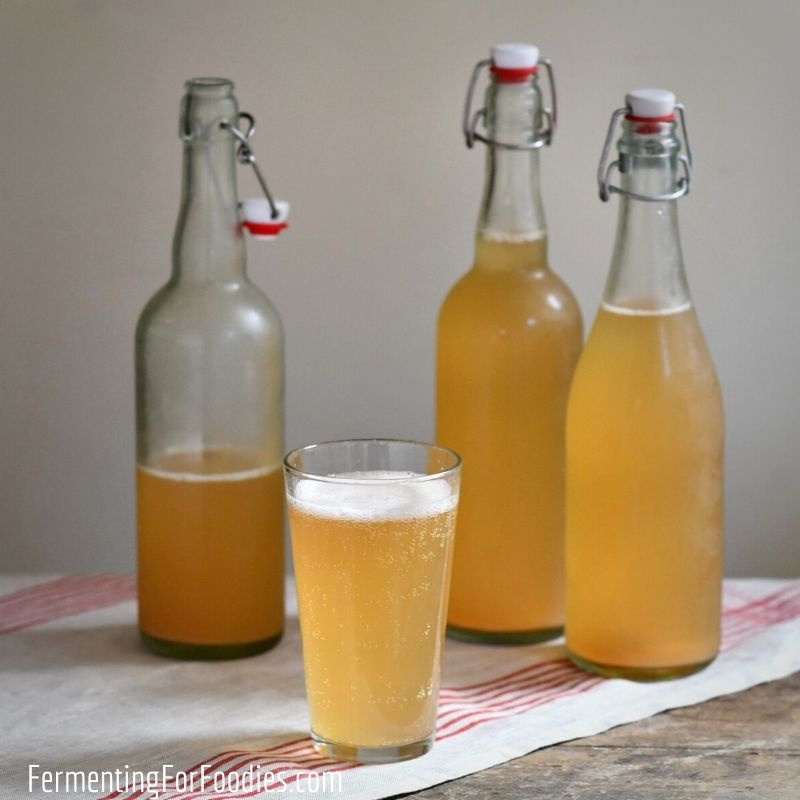
In order to run this site, Fermenting For Foodies sometimes earns an affiliate commission on the sales of products we link to. We only feature items we genuinely want to share, and this is an arrangement between the retailer and Fermenting For Foodies. Readers never pay more for products. Thank you for reading!
Here are a few of the reasons why I prefer homemade hard apple cider to store-bought versions:
- Simple: Using store-bought jugs of juice eliminates the need to sanitize equipment. Just add the ingredients, pop in a $2 airlock and you’re done!
- Dry or sweet: I like really dry cider, so I let my cider keep fermenting until it is as dry as possible. If you like sweet cider, then stick it in the fridge early.
- Fun fruit flavors: Making apple berry cider is easy! Just use a mix of fruit juices for a fun and flavorful cider.
- Affordable: Apple juice is much cheaper than hard apple cider. And if you’re lucky enough to have an apple tree, then using your own pressed apples means that making hard apple cider is practically free!
- Sulfite-free: Store-bought hard cider contains a lot of sulfites. Even if you don’t have a sulfite allergy, you may be sensitive to the load of sulfites in commercial hard cider. This hard apple cider recipe is sulfite-free!
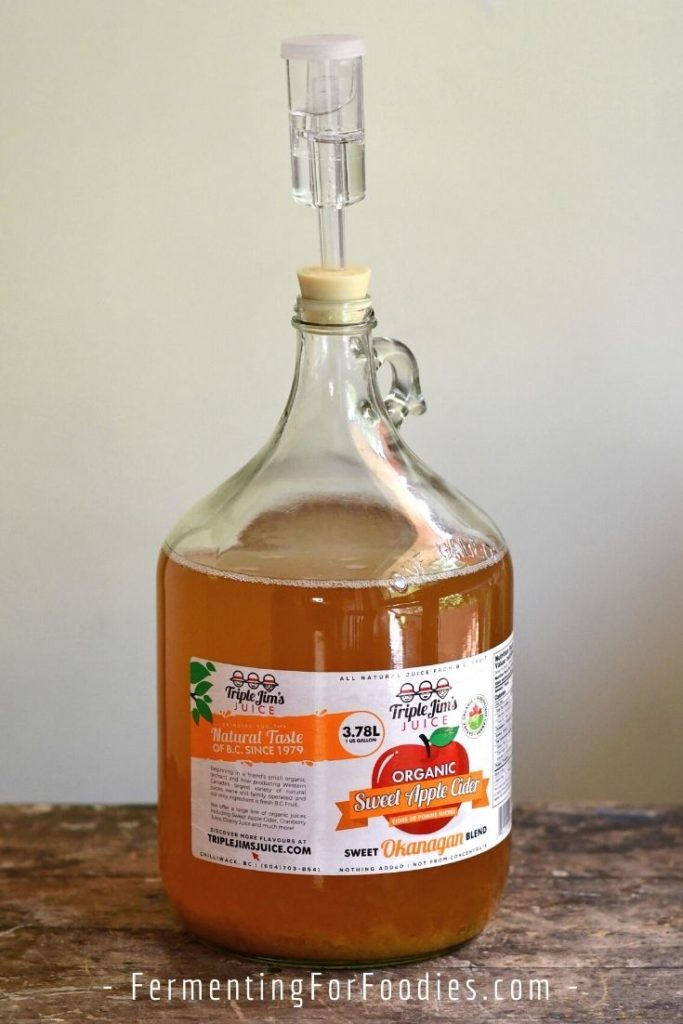
Newbies Start Here
If this is your first time making homemade cider or wine, then here are a few things you should know:
- This recipe can be made without added sugar or yeast nutrient, however, it won’t ferment as well. The resulting cider will be low alcohol and probably won’t carbonate with this recipe. If you want to make cider without added sugar, here’s my simple fruit juice cider. It doesn’t require sugar or yeast nutrient.
- I recommend getting a hydrometer. They are only about $20 and will help you measure the sugar levels and tell you when your cider is ready for bottling.
- Sanitizing the bottles isn’t required, however, it is the best way to prevent your cider from going off. Here’s a whole post on how to sanitize for cider and wine.
- Want more information on making cider and wine? Here’s a basic overview of everything you need to know to make cider at home.
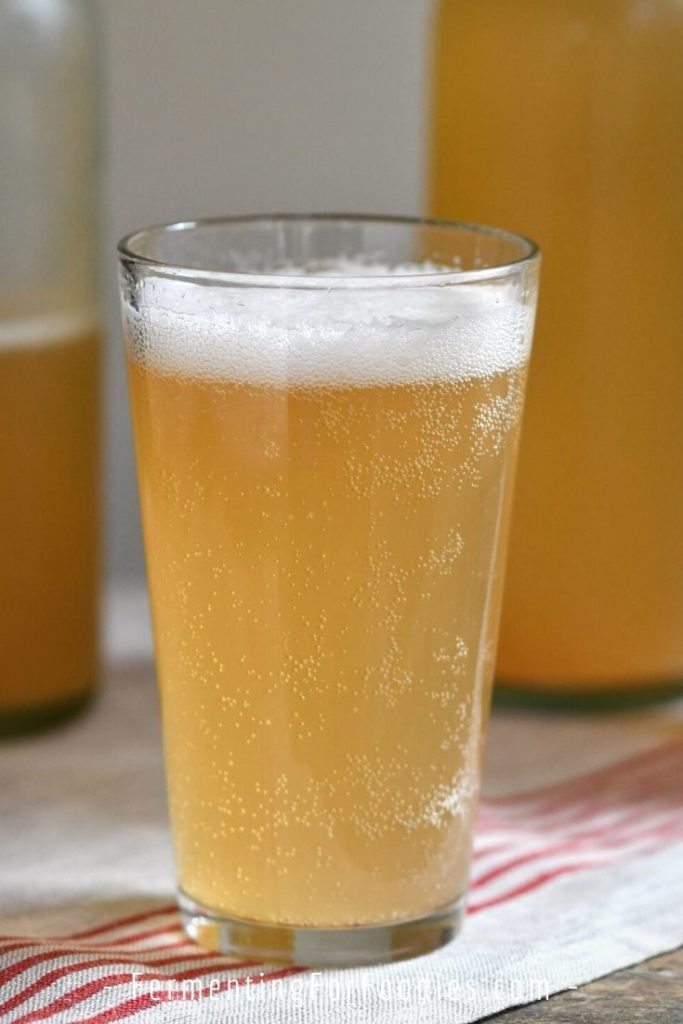
Hard Apple Cider From Juice
Using store-bought apple juice is the easiest way to make hard apple cider. This simple recipe is so delicious and easy that it’s perfect for beginners. Best of all, homemade apple cider is sulfite-free!
- Prep Time: 15 minutes
- Total Time: 15 minutes
- Yield: 1 gallon 1x
- Category: Alcohol
- Cuisine: British
- Diet: Vegan
Ingredients
Units
Scale
- 1–gallon jug of apple juice (see notes)
- 1/4 package white wine yeast (Lalvin EC 1118)
- 1/4 tsp yeast nutrient
- 1 cup sugar (optional)
- 2 Tbsp white sugar or dextrose (for priming)
- 1/4 cup water
Instructions
- Be sure to sanitize anything that is going to touch the cider. If you are fermenting in a store-bought jug of apple juice, then you will only need to sanitize for racking and bottling.
- Remove 1/2 cup of juice from the jug. This will leave enough room to prevent the fermentation from bubbling over. I recommend testing the sugar content of your apple juice using a hydrometer. It needs to be at least 1.050. Feel free to add up to 1 cup of sugar, as needed. This will increase the potential alcohol content and/or sweeten the cider.
- Add the yeast and yeast nutrient. Put the cap back on the bottle of juice and give it a good shake to mix everything up. Remove the lid and top the bottle with an airlock.
- If you are using unfiltered apple juice, then you will need to rack the cider to a clean jug after 1 week. If you are using filtered apple juice, then racking isn’t necessary.
- Allow the cider to ferment for 2-4 weeks (1-3 weeks after racking) before bottling. Exactly how long you leave the cider to ferment will depend on your personal taste. If you like sweet cider, bottle it after 2 weeks. Wait 4 weeks for a dry cider.
- To prime the carbonation, mix 2 Tbsp of white sugar or dextrose in 1/4 cup of boiling water. Stir to dissolve the sugar. Add the sugar water to the cider just before bottling.
- Leave the bottled cider to ferment at room temperature for another 5 to 10 days, until it is carbonated. Store the cider in the fridge and enjoy it within 2 months. Because this recipe is a sulfite-free recipe the cider is not shelf-stable and it will continue to ferment, even in the fridge. So if you like sweet cider, drink it within 1 month.
Notes
- If you are using homemade apple juice, you will need to pasteurize it to prevent contamination from wild mold, yeast, and bacteria. To pasteurize the juice, bring it to a boil and simmer for 5 minutes. Then pour into the fermenting jug and allow to cool to just above room temperature before adding the yeast.
- Don’t use apple juice that contains additional sugar, preservatives, or additives. All you want on the label is juice and Vitamin C (ascorbic acid).
- Don’t use juice made from concentrate.
- Feel free to use juice that is a mix of apples and berries. Avoid citrus, bananas, and tropical fruits which don’t ferment as nicely. (They tend to make the yeast become stringy, which isn’t very pleasant).
- A hydrometer isn’t necessary, however, it’s the easiest way to test how much sugar is in the apple juice and when it is ready for bottling. Otherwise, you can just guestimate using the recipe.
- I like to use brown sugar, which adds a depth of flavor, however, white sugar is fine as well.
- Be sure to use bottles that can handle the buildup of carbonation. Either plastic pop bottles or flip-top beer/cider bottles. Test for carbonation by squeezing on a plastic bottle or popping open one of the flip-top bottles.
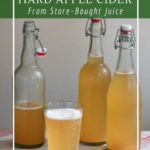
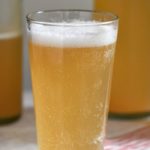
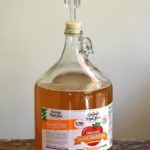
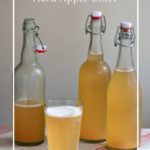
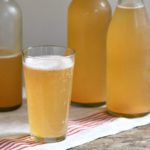
If I am doubling the recipe, do I need to double the amount of priming sugar? Thank you.
Yes! Otherwise you’ll have slightly flat cider. 🙂
In the case of doubling to 2 gallons would you just double everything including the amount of yeast?
Yes, to ensure that it ferments at the right speed, you’ll need double the yeast (so 1/2 package). Enjoy!
Am trying this so far cost me £5 for stuff but hopefully get 20 bottles cider…
Great! And I imagine that you’ll be able to reuse some of the supplies, like the airlock. Enjoy!
Every fall our grandfather drove from Michigan to our home in Texas with his station wagon loaded down with apples, dried mushrooms, honeycones from his apiary and apple cider, which apparently had started to ferment because it always had a little bite. Is it possible that it fermented on its own or must we assume he did something to make this happen?
That sounds amazing. The cider may have fermented with wild yeast, depending on your grandfather’s cleanliness. Or if he added a bit of homemade honey, then he was making apple mead. Raw honey naturally contains yeasts and bacterial culture.
I used to buy unpasturized cider in gallon milk jugs farmer direct in michigan. $1 a jug,all i did was crack the cap a lil.natural yeasts on apples fermented it just fine.
Yes! Wild yeast can definitely make hard cider. And it naturally dies off at about 4% alcohol for a sulfite-free cider!
I just began my hard cider using your recipe. It’s the second day and it’s super foamy on the top! I have a question: when I started, I added a bit of sugar to get the liquid up to 1.050 on my hydrometer. How high of alcohol percentage do you think this drink will go up to if I let it sit for 2 weeks and 4 weeks? Thanks! Super excited for this to work out! I did half your recipe with a half gallon jug of apple juice and used boiled bakers yeast as yeast nutrients.
Hi Hugh, As you probably already know, the max alcohol percentage is 6.8, however, that would be a very dry cider. I find that after 2 weeks the cider is still very sweet, so maybe 3% then it will slowly get closer to 6 % as you get to the 4-week point. However, if you can bear siphoning a bit off to test, then you can bottle it at your ideal sweetness and alcohol level. Enjoy!
Awesome! I don’t know why I didn’t think of siphoning to test it! Thank you, I look forward to it! Question: I noticed that the foam on my batch was very very foamy the first 2 days but it has slowed down quite a bit and the amount of foam dissipated. Is that normal? Also, I noticed a clumping of yellow-ish beige-ish stuff in the foam. What could this be?
The initial foaming is normal, and it usually does slow down after the first few days. The yellow stuff could be spent yeast? If it seems excessive you could always rack it to a new bottle. Spent yeast doesn’t taste good… but if you bottle after 2 weeks, it’s probably not necessary to rack it as it won’t have as much time to flavour the cider. However, if you’re making wine, it really is necessary to rack to clean containers to remove spent yeast. I learned that lesson the hard way!
Hi after 1 week there seems to be a little mould forming on top is this a concern?
It’s more likely kahm yeast. Is it white and frost-like (versus 3D and fluffy, mold-like?) Kahm yeast is not an issue… mold is an issue. If it’s mold, I recommend scrapping the ferment. At best, removing the mold and heat pasteurizing it. You can just ignore kahm yeast which will naturally die off. Cheers, Emillie
My local brewing supply store recommend using yeast killer tablets to avoid wild yeast. How many BSG brand tablets should be used? A 2 oz. bag contains at least 100 tablets.
Hi Scott, I’m really sensitive to sulfites, so I’ve never actually used them in any of my wine/cider recipes. Sorry, I’m not the right person to ask. Perhaps you could post it as a question on my facebook group: Fermenting For Everyone? https://www.facebook.com/groups/896706654496177/ Alternatively, if you are using store-bought juice, then you really don’t need to worry about wild yeasts and the pasteurization would have taken care of that. Cheers!
Hello, we’re just about to start making cider for the first time but need it to have a much longer shelf life due to the fact that my son is who ere making it for and we don’t know when he will be back (coeliac so can’t drink beer). Is there a way to increase shelf life pls?
Hi Nelle, Sulfites, and sorbate are added to cider to stop fermentation (and increase the shelf-life). Here’s a good post on how to add Campden (sulfites) and sorbate to stop fermentation in cider. https://www.homecidermaking.com/how-to-stop-cider-fermentation/ Personally, I haven’t tried it as I’m sensitive to sulfites. I just pop the cider in the fridge. If you have a second fridge and can keep it in the fridge, it could last for several months. Bottle after 4 weeks (so most of the fermentation will have finished) and be sure to use a bottle that can handle the buildup of carbonation. Enjoy!
Thank you so much
For years we collected wild apples and took them to a local cider press for pressing. The cider we brought home I canned in mason jars for juice but we always let a few gallons go fizzy in the plastic jugs. They were always delicious, no mold or off flavors, and we either had to drink them up or freeze them before they got too alcoholic and flat for us. Now I have apples from my trees but use a champion juicer to juice small batches. I then strain the juice through a jelly bag. The resulting juice is extremely cloudy. My question is, will there be a problem with all the suspended matter, or will it settle during fermentation? Also, I do not want a very high alcohol content and am also allergic to sulfites. If I let it ferment with wild yeasts, can I just bottle it when the fermentation slows or stops and, if so, need I add a little sugar to get the carbonation?
Thanks,
Hi Freyda, The solids will definitely settle out during fermentation. If you have an auto-siphon, it can really help with clarifying cider. However, even if the solids end up in your final bottle, they tend to sink and you can just pour away the sludge at the bottom.
As for wild yeast fermentation, it can definitely work. However, there’s always an added risk of contamination by mold or bacteria. So I guess it depends on how you feel about the potential of failure. 🙂
I’m also sensitive to sulfites. It’s why all my recipes are sulfite-free. Stopping the fermentation is a bit tricky with commercial yeast, however, if you also want a low-alcohol cider, then I recommend not adding any extra sugar for the initial ferment. That will result in a very dry, low alcohol cider. Then add the priming sugar for carbonation when you bottle it. If it’s not sweet enough, then just add a bit of sugar right when you serve it. Cheers!
I pressed my apples, now how long do I have before I pasturize and ferment. Iam very busy with other things. I have it in a 5 gallon carboy in my cooler…Thanks…Ron
Are you able to do it in the next 3-5 days? I wouldn’t leave it too long, as it may start to ferment on its own. That would more likely result in vinegar than hard cider. Enjoy!
I was wondering I made my own apple juice in my recipe it said to heat the juice on the stove at 190f for 5 mins than do the water bath canning for 10 mins
Would this be considered pasteurized and could use just like that for this recipe there is no sugar added
Thanks
Yes and yes! The sugar just affects the overall alcohol levels. If you have a hydrometer then you can measure the sugar in your juice to figure out the potential ABV. Otherwise, it should ferment to about 5% without any additional sugar. Enjoy!
How do I rack the cider and what other materials will I need? Thanks!
Hi John, Racking is when you move the liquid to a clean container (usually to clarify and remove the yeast). Probably the best way to use this recipe is to refer to the related topics. I have a whole post on equipment and supplies needed for making cider. It was just easier than rewriting everything into each post. 🙂 Here is the link: https://www.fermentingforfoodies.com/cider-wine-equipment-supplies/ And here’s a link that organizes all the topics related to cider making: https://www.fermentingforfoodies.com/homemade-cider-wine/
Good luck! Emillie
If I think the cider is too bitter before bottling can I add more sugar to sweeten before bottling? Or should I let this work out a week more in first fermenter?
Yes! Cider can be as sweet as you want, and you can always add more sugar. The sweetness will depend on how sweet the apple juice was along with any additional added sugar. Did you try a bit before fermenting? Was it quite tart and bitter?
Can I distill this and what would it be like
Hi, For all sorts of reasons (mostly legal) I cannot recommend making distilled alcohol. It requires an incredible level of cleanliness and precision to make sure the resulting brandy is safe to drink. Any contamination by methanol-producing bacteria is amplified by distillation.
However, it is safe and easy to increase the alcohol content for a more wine-like beverage. Simply increase the amount of sugar and allow it to ferment for an additional 4 weeks. It won’t be sweet or sparkling, however, if you use champagne yeast, it should ferment up to 18 ABV. Saying that I haven’t personally tried it, so you may need to add yeast energizer to boost the ferment if it slows down. The best way to figure out how much sugar to add, and whether you need to add energizer is to use a hydrometer to keep track of the ferment.
Cheers, Emillie
Hallo Emillie, compliments to your attractive and clear website!
I have a genral question about your recipe for making cider from apple juice.
Does it make a difference whether you add sugar to the applejuice before it starts fermenting, or right before you bottle the fermented juice?
Hi Wim,
Glad you enjoy the website! The timing of the added sugar does make a difference. Sugar is added to the first round of fermenting to increase the alcohol level. It will determine the final ABV. Sugar added at bottling is to prime the carbonation. So you only want to add just enough to carbonate the cider, not too much or it will be explosive. 🙂 Enjoy!
What happens if you use juice from concentrate?
I’m not sure. Apple juice is one of the local products around here, so it’s pretty plentiful. It probably should be fine, since it’s really the same thing, but without the additional water. If you try it, add chlorine-free water. Otherwise, the chlorine in the water could slow down the ferment. Good luck!
Hi Emilie – per your guidance on another post I’m using this recipe with my plum juice and it’s all mixed and fermenting now for 3-4 days. Is stirring or removing airlock to stir required or just let it sit for the time recommendation? I see on making wine you stir every day so wanted to make sure I am not missing a step. Thanks!
Hi Danielle, Stirring is not required when fermenting juice in an airlock. The plum wine is fermented with whole fruit, and the fruit floats. So it needs to be stirred to make sure the fruit gets submerged in the liquid. Please let me know how this works for you! We don’t have a juicer, so I’ve only done whole fruit wines. Cheers, Emillie
Hi Emilie! I have a jug of apple cider that’s been in the fridge for several weeks. Open it today and noticed the plastic jug was puffed up tight and little air escaped when I cracked the lid. Is it possible to use it to make hard cider. Little over half a gallon. Thanks
Hi Randy,
This is a bit of a tricky subject, as I certainly don’t want you to drink anything that might make you sick! Your apple juice definitely fermented. However, you don’t necessarily know what caused it to ferment. If it was raw, unprocessed apple juice, then there’s a good chance that it naturally turned into hard cider. It may also be on its way to turning into vinegar. Or it could be fermenting with something less desirable.
For legal reasons… I definitely have to tell you not to drink it. Saying that, if it were me… I would give it a little sniff. If it smelled good, then I would taste just the tiniest amount. If it didn’t taste like ACV or hard cider, then I would pour it out. Good luck!
hey, i have my white wine yeast in a box thing, how many teaspoons is 1/4 packet?
the internet says it is 1/4 tsp, but wanted to check with the chef herself !
Interesting… I have never bought a box of yeast before. I agree, there is about 1 tsp of yeast in a packet, so 1/4 tsp is perfect. Enjoy!
You say you use brown sugar instead of white, how about raw honey? If I were to use it instead of sugar, do you know how much I should use for this recipe? Great post. Can’t wait to try it out. Thanks!
Hi Hank,
Raw honey has its own yeast and bacterial culture, so if you use it to make cider, you’ll end up with a mead-cider concoction. 🙂 Feel free to use either brown or white sugar. I just like the flavor of brown sugar. If you really want to use raw honey, heat it up first to kill the natural cultures. Umm… I’m feeling inspired. I think I need to brew another batch of hard cider! Cheers, Emillie
What about adding Everclear to “punch it up” a bit.
I wouldn’t do that when brewing the cider, as it might slow or stop the fermentation. However, feel free to mix it in when you serve it! Cheers, Emillie
Hello!
Do you have a post with instructions on how to make cider with a 5Gallon beer brewing kit? Would it be the same recipe just x5?
Thank you,
Amber
Hi Amber, This recipe can absolutely be scaled up to 5 gallons. Starting with a beer kit is great because you’ll have the carboy, air-lock, and sanitation chemicals. I don’t recommend using beer yeast though. 😉 Stick with a wine yeast which is better adapted for fermenting fruit.
Enjoy!
Hi there,
Is it possible to age or ferment this cider in an oak barrel ?
Hi Marcello, I haven’t tried aging cider in an oak barrel. (I live in a downtown urban townhouse, with no space for such things). My suggestion would be to rack to the oak barrel after the first 2 weeks of fermenting. Then let it age for 2 weeks before bottling. (Keeping the same 4 week fermentation schedule, but not doing the primary ferment in the oak barrel).
Cheers, Emillie
Wondering why juice from concentrate should not be used? Almost. if the varieties in the local supermarket were unfortunately from concentrate. what about froze juice concentrate to bring up the gravity?
Thanks
Hello, In general, I recommend using the highest quality juice for brewing cider. You’ll end up with a better flavored beverage. Juice from concentrate isn’t the same as regular juice. Even 100% juice from concentrate has had pulp and flavors removed. It’s also more likely to have additives (flavors added back in and preservatives).
If you have absolutely no other option, you can certainly make cider from concentrate. However, I don’t recommend frozen juice concentrate for sugar. Juice is mostly fructose, and the wine yeasts thrive on sucrose and glucose. Cheers!
This looks great and I have done many ciders w some from my own trees but I am having trouble reading it w all the pop-ups. Can we get a simple pdf?
Thx
I’m sorry you had issues. There shouldn’t be ANY pop ups on my site. I haven’t allowed them. However, sometimes ads “take over” (my ad providers words). In that case, I’m suppose to report the ad and they’ll remove the advertisers access. (I honestly, don’t know how this works…) Try again, then send me a screenshot if you have any issues.
You should be able to print my recipes… though if the pop ups are an issue, maybe you can’t see the print button? You can print to PDF.
Cheers! Emillie
I’m making apple wine with a champagne yeast. Can I make some of this into ACV by adding some Braggs ACV to my wine? If so, how long would I leave this in a carboy before bottling?
I actually wrote a post on this exact topic. Basically, add ACV when your wine is mostly finished. You want the sugars fully converted to alcohol. Braggs is a great starter culture. If you want more details, here’s the post I wrote: https://www.fermentingforfoodies.com/how-to-make-wine-vinegar/ Enjoy!
Hi Emilie,
I just ran across your site. I plan on trying you cider recipe. But out of curiosity, I am sitting drinking a hard cider, and it lists an 8% abv. I didn’t think that was possible without some distillation?
Hi Steve,
Cider is typically made with champagne yeast… so if it’s not curbed with sulfites or refrigeration it could get to 18% abv! So your delicious bottle of cider was not distilled. If it’s quite dry, then the alcohol may be naturally controlled by the amount of sugar. Otherwise, 8% is what the makers intended.
Cheers, Emillie